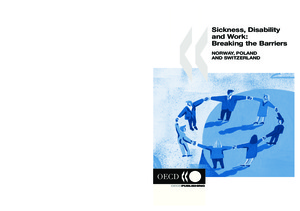Sickness, disability and work : breaking the barriers. Volume 1 : Norway, Poland and Switzerland
"Too many workers leave the labour market permanently due to health problems, and yet too many people with a disabling condition are denied the opportunity to work. This is a social and economic tragedy common to virtually all OECD countries, and an apparent paradox that needs explaining. Why i...
| Institution: | ETUI-European Trade Union Institute |
|---|---|
| Format: | TEXT |
| Language: | English |
| Published: |
Paris
2006
OECD |
| Subjects: | |
| Online Access: | https://www.labourline.org/KENTIKA-19188160124919063429-Sickness,-disability-and-work-.htm |
| Summary: | "Too many workers leave the labour market permanently due to health problems, and yet too many people with a disabling condition are denied the opportunity to work. This is a social and economic tragedy common to virtually all OECD countries, and an apparent paradox that needs explaining. Why is it that health is improving, yet more and more people of working age end up out of the workforce relying on long-term sickness and disability benefits?
This first report in a new OECD series on sickness, disability and work explores the possible factors behind this paradox. It looks specifically at the cases of Norway, Poland and Switzerland, and highlights the role of institutions and policies. A range of reform recommendations is put forward.
In all three countries, too little is done to avoid the flow from work to benefits and to move benefit recipients back to employment. At the same time, financial incentives to work and obligations for disabled people on benefits as well as employers are too weak. Many people with health problems can work, and want to work, so having a policy based around an assumption that they cannot work is fundamentally flawed. Helping those people to work is potentially a true ‘win-win’ policy: it helps people avoid exclusion and have higher incomes, at the same time as raising the prospect of higher economic output in the long term." |
|---|---|
| Physical Description: | 172 p. Digital |

